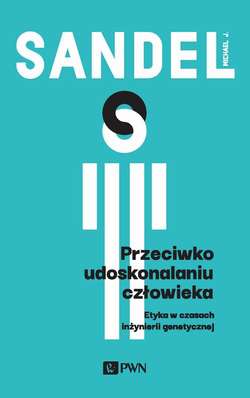Читать книгу Przeciwko udoskonalaniu człowieka - Michael J. Sandel - Страница 8
На сайте Литреса книга снята с продажи.
Przypisy
ОглавлениеRozdział 1
1 W oryginale Michael J. Sandel używa sformułowania deaf-pride community, mając na myśli społeczność głuchych, którzy uznają brak słuchu nie za formę upośledzenia, ale cechę będącą podstawą wytworzenia ich specyficznej i przekazywanej następnym pokoleniom kultury, opartej m.in. na języku migowym. Więcej zob. np. Harlan Lane, Maska dobroczynności. Deprecjacja społeczności głuchych, tłum. T. Gałkowski, J. Kobosko, Warszawa 1996, oraz Carol A. Padden, From the cultural to the bicultural: the modern Deaf community, w: I. Parasnis (red.) Cultural and Language Diversity and the Deaf Experience, (Cambridge, UK: Cambridge Univ. Press 1996) [przyp. red].
2 Margarette Driscoll, „Why We Chose Deafness for Our Children”, The Sunday Times (London), 14 kwietnia 2002 r. Zob. też Liza Mundy, „A World of Their Own”, Washington Post, 31 marca 2002 r., s. W22.
3 Driscoll, „Why We Chose Deafness”.
4 SAT (ang. Scholastic Assessment Test) – ustandaryzowany test dla uczniów szkół średnich w USA badający kompetencje i wiedzę przedmiotową [przyp. red.].
5 Zob. Gina Kolata, „$50,000 Offered to Tall, Smart Egg Donor”, New York Times, 3 marca 1999 r., s. A10.
6 Alan Zarembo, „California Company Clones a Woman’s Cat for $50,000”, Los Angeles Times, 23 grudnia 2004 r.
7 Strona internetowa firmy Genetic Savings & Clone: http://www.savingsandclone.com; zob. też Zarembo, „California Company Clones a Woman’s Cat”.
8 Wyrażenie „lepiej niż dobrze” [ang. better than well – przyp. tłum.] zaczerpnięte z tytułu książki Carla Elliotta Better Than Well: American Medicine Meets the American Dream (New York: W.W. Norton, 2003). Elliott cytuje tekst Petera D. Kramera, Wsłuchując się w Prozac, tłum. Maria Szwed-Szelenberger, Waldemar Szelenberger, Warszawa: Jacek Santorski & CO, 1995.
9 E.M. Swift, Don Yaeger, „Unnatural Selection”, Sports Illustrated, 14 maja 2001 r., s. 86; H. Lee Sweeney, „Gene Doping”, Scientific American, lipiec 2004, s. 62–69.
10 Richard Sandomir, „Olympics: Athletes May Next Seek Genetic Enhancement”, New York Times, 21 marca 2002 r., s. 6.
11 Rick Weiss, „Mighty Smart Mice”, Washington Post, 2 września 1999 r., s. A1; Richard Saltus, „Altered Genes Produce Smart Mice, Tough Questions”, Boston Globe, 2 września 1999 r., s. A1; Stephen S. Hall, „Our Memories, Our Selves”, New York Times Magazine, 15 lutego 1998 r., s. 26.
12 Hall, „Our Memories, Our Selves”, s. 26; Robert Langreth, „Viagra for the Brain”, Forbes, 4 lutego 2002 r.; David Tuller, „Race Is On for a Pill to Save the Memory”, New York Times, 29 lipca 2003 r.; Tim Tully et al., „Targeting the CREB Pathway for Memory Enhancers”, Nature nr 2 (kwiecień 2003): s. 267–277; www.memorypharma.com.
13 Ellen Barry, „Pill to Ease Memory of Trauma Envisioned”, Boston Globe, 18 listopada 2002 r., nr 132, s. A1; Robin Marantz Henig, „The Quest to Forget”, New York Times Magazine, 4 kwietnia 2004 r., s. 32–37; Gaia Vince, „Rewriting Your Past”, New Scientist, 3 grudnia 2005 r., s. 32.
14 Marc Kaufman, „FDA Approves Wider Use of Growth Hormone”, Washington Post, 26 lipca 2003 r., s. A12.
